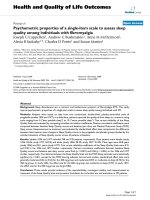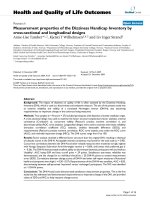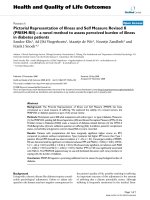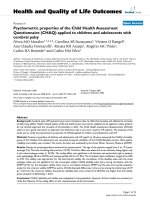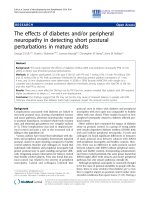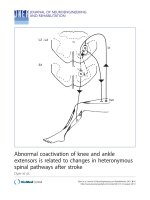Báo cáo hóa học: " Thermodynamic Properties of Supported and Embedded Metallic Nanocrystals: Gold on/in SiO2" pptx
Bạn đang xem bản rút gọn của tài liệu. Xem và tải ngay bản đầy đủ của tài liệu tại đây (367.63 KB, 7 trang )
NANO EXPRESS
Thermodynamic Properties of Supported and Embedded Metallic
Nanocrystals: Gold on/in SiO
2
F. Ruffino Æ M. G. Grimaldi Æ F. Giannazzo Æ
F. Roccaforte Æ V. Raineri
Received: 17 July 2008 / Accepted: 17 September 2008 /Published online: 9 October 2008
Ó to the authors 2008
Abstract We report on the calculations of the cohesive
energy, melting temperature and vacancy formation energy
for Au nanocrystals with different size supported on and
embedded in SiO
2
. The calculations are performed crossing
our previous data on the surface free energy of the sup-
ported and embedded nanocrystals with the theoretical
surface-area-difference model developed by W. H. Qi for
the description of the size-dependent thermodynamics
properties of low-dimensional solid-state systems. Such
calculations are employed as a function of the nanocrystals
size and surface energy. For nanocrystals supported on
SiO
2
, as results of the calculations, we obtain, for a fixed
nanocrystal size, an almost constant cohesive energy,
melting temperature and vacancy formation energy as a
function of their surface energy; instead, for those
embedded in SiO
2
, they decreases when the nanocrystal
surface free energy increases. Furthermore, the cohesive
energy, melting temperature and vacancy formation energy
increase when the nanocrystal size increases: for the
nanocrystals on SiO
2
, they tend to the values of the bulk
Au; for the nanocrystals in SiO
2
in correspondence to
sufficiently small values of their surface energy, they are
greater than the bulk values. In the case of the melting
temperature, this phenomenon corresponds to the experi-
mentally well-known superheating process.
Keywords Nanocrystal Á Surface energy Á Gold Á
SiO
2
Á Cohesive energy Á Melting temperature Á
Vacancy formation energy
Introduction
The physical and chemical properties of low-dimensional
solid-state systems draw considerable attention, in the
previous years, because of their technological importance
[1, 2]. In particular, the properties of nanocrystals (NCs)
differ from that of the corresponding bulk materials, mainly
due to the additional energetic term of c
0
A, i.e. the product
of the surface excess free energy c
0
and the surface area A.
This term becomes significant to change the physical and
chemical properties of the NCs (with respect to the bulk
material) due to the large surface/volume ratio of such
systems. So, the properties of NCs bridge those of bulk
materials and atomic scale systems [3]. Also, the thermo-
dynamic properties of NCs are different from that of the
corresponding bulk materials and the study of such prop-
erties acquired a fundamental relevance in the last decades
[4–34] because of their applications in the field of micro-
electronics, solar energy utilization and nonlinear optics.
For example, nowhere is the interest in the thermodynamics
of materials at small dimensions than in the microelec-
tronics industry, where transistors and metal interconnects
will have tolerances of only several nanometres [35]. One
particular phenomenon of interest is, for example, the size-
dependent melting point of NCs with respect to the corre-
sponding bulk materials [4–11]: this phenomenon received
considerable attention since Takagi in 1954 experimentally
F. Ruffino (&) Á M. G. Grimaldi
Dipartimento di Fisica e Astronomia, Universita
`
di Catania,
via S. Sofia 64, I-95123 Catania, Italy
e-mail: francesco.ruffi
F. Ruffino Á M. G. Grimaldi
MATIS CNR-INFM, Catania, Italy
F. Giannazzo Á F. Roccaforte Á V. Raineri
Consiglio Nazionale delle Ricerche—Istituto per la
Microelettronica e Microsistemi (CNR-IMM) Stradale
Primosole 50, I-95121 Catania, Italy
123
Nanoscale Res Lett (2008) 3:454–460
DOI 10.1007/s11671-008-9180-y
demonstrated that ultrafine metallic NCs melt below their
corresponding melting temperature [4]. It is now known
that the melting temperature of all low-dimensional solid-
state systems (NCs, nanowires and nanosheets), including
metallic [5–8], organic [9, 10] and semiconductor [11]
depends on their size. For free standing NCs, the melting
temperature decreases as its size decreases, while for NCs
supported on or embedded in a matrix, they can melt below
or above the melting point of the corresponding bulk crystal
depending on the interface structure between the NCs and
the surrounding environment (the substrate or the matrix)
[12–18]. If the interfaces are coherent or semi-coherent, an
enhancement of the melting point is present: this phenom-
enon is called superheating [12–14, 16, 18]. Otherwise,
there is a depression of the melting point [16–18]. Not only
the melting temperature but also several thermodynamic
parameters, such as cohesive energy (the energy needed to
divide the crystal into isolated atoms) and vacancy forma-
tion energy (the energy to form a vacancy in the NC in
thermodynamic equilibrium) of NCs have been the subject
of several experimental [19] and theoretical [18, 20–28]
studies. Several methods have been developed and used to
measure the thermodynamic properties of nanosystems
(nanocalorimetry [17], scanning probe microscopy [29, 30],
transmission electron microscopy [31], X-ray diffraction
[32]) and different models were developed to describe the
size-dependent thermodynamic properties of such systems
(BOLS model [20], latent heat model [21], liquid drop
model [18], surface-area-difference (SAD) model [22, 23],
bond energy [24]). So, the importance of the combination of
experimental and theoretical works towards a complete
understanding of the thermodynamic properties of free-
standing, supported and embedded nano-systems is clear.
In a previous experimental work [33], we fabricated
supported/embedded Au NCs on/in SiO
2
. Using high-res-
olution transmission electron microscopy (HR-TEM) and
by the inverse Wulff construction, we were able to obtain
the angular-dependent surface energy c
0
(h) of the supported
and embedded NCs as a function of their size. The main
result of that work was that growing NCs surrounded by an
‘isotropic’ environment (Au in SiO
2
) exhibit an angular and
radial symmetrical surface free energy function c
0
(h)
making the surface stress tensor f
ij
of the NC rotationally
and translationally invariant: this situation determines a
symmetrical equilibrium shape of the NCs. Growing NCs in
a ‘non-isotropic’ environment (Au on SiO
2
) exhibit a sur-
face energy c
0
(h), that lost its angular and radial symmetry
for sufficiently large sizes, determining the loss of the
rotational and translational invariance of the f
ij
and, as a
consequence, a loss of symmetry in the equilibrium shape of
the NC and the formation of internal defects.
In the present paper, we cross our experimental data
concerning the surface free energy of the Au NCs
supported on SiO
2
and embedded in SiO
2
with the SAD
theoretical model of Qi [23] for the description of the size-
dependent thermodynamic properties of metallic NCs, to
simulate (and so to predict) the cohesive energy, the
melting temperature and the vacancy formation energy for
the Au NCs supported on and embedded in SiO
2
. In par-
ticular, we compare such quantities for Au NCs with the
same size but supported or embedded on/in the SiO
2
layer
finding significant differences derived from the different
effects of the surrounding environment. We believe that
our theoretical results can improve the understanding of the
thermodynamic properties of NCs and can guide future
experimental investigations.
Experiment and results
Cz- \ 100 [ silicon substrates (with resistivity
q % 6 Â10
À3
X cm) were etched in a 10% aqueous HF
solution to remove the native oxide, and subsequently
annealed at 1,223 K for 15 min in O
2
in order to grow an
uniform, 10 nm thick, amorphous SiO
2
layer. A 2-nm thick
Au film was deposited (at room temperature) by sputtering
on the SiO
2
layer using an Emitech K550x Sputter coater
apparatus (Ar plasma, 10
-4
Pa pressure). In some samples,
the Au layer was covered by a 3-nm thick SiO
2
layer
deposited (at room temperature) by sputtering using an
AJA RF Magnetron sputtering apparatus (Ar plasma,
1.3 9 10
-8
Pa pressure). Then, the Au/SiO
2
and SiO
2
/Au/
SiO
2
samples were contemporary annealed in Ar ambient
in the 873–1073 K temperature range and in the 5–60 min
time range to obtain the growth of NCs [33, 34].
The samples were analyzed by HR-TEM (after
mechanical polishing and final Ar ion milling) using a Jeol
2010F energy-filtered transmission microscope (EF-TEM),
operating at 200 kV and equipped with a Gatan image
filtering apparatus. Before the cross-sectional TEM analy-
ses of the samples with Au on SiO
2
, a thin SiO
2
cap-layer
(*3 nm) was deposited (by sputtering with the AJA RF
Magnetron apparatus) on the samples in order to protect the
NCs during the samples preparation.
From the HR-TEM images of the Au NCs embedded in
SiO
2
, with diameter in the range 2 nm \ D \ 7nmitis
clear that they conserve an equilibrium shape symmetry
(single icosahedral crystal) increasing the size [33, 34].
Differently, the Au NCs growing on SiO
2
, belong to
three different groups on the basis of their equilibrium
shape and internal atomic structure, as a function of their
diameter D (in the range 2 nm \ D \7 nm for our case):
group 1: formed by NCs with a diameter D \ 3 nm.
They have a structure such as the Au NCs in SiO
2
, i.e.
single icosahedral crystal;
Nanoscale Res Lett (2008) 3:454–460 455
123
group 2: formed by NCs with a diameter 3 nm \
D \ 4 nm. They have an icosahedral structure charac-
terized by twins of the (111) atomic planes;
group 3: formed by the NCs with a radius 4 nm \
D \ 14 nm. They have a complicated decahedral multi-
twinned (and lamellar) structure.
We extracted quantitative information on the surface
free energy from these NCs shape via the inverse Wulff
construction [33] that gives the dependence of the step free
energy on the orientation starting from the NC equilibrium
shape. In fact, it is possible to construct the inverse of the
free energy as the minimal surface of the Wulff-construc-
tion to the shape of 1/r(h) : first, we identified the ‘Wulff
point’ of the NC as the intersection point between the
perpendicular bisectors of two {111} facets. This point was
taken as the centre of a polar plot, with angular and radial
coordinates h and r. For each given ray projecting from the
origin of the polar plot in the angle h
i
(measured with a 5°
spacing), we searched for the perpendicular which is a
tangent to the equilibrium shape. Then we measured the
distance r
i
between the Wulff point and this tangent.
According to the Wulff relation c
0
ðh
i
Þ=rðh
i
Þ¼k ¼ const,
the value of the surface free energy for the NCs c
0
(h
i
) for
those orientation was obtained and the c
0
(h) plot was
determined. The results shown in Fig. 1 were the obtained
c
0
(h
i
), and are reported as normalized to the surface free
energy of the (111) plane of the Au (1.363 J/m
2
,[18]).
Figure 1a shows the obtained c
0
(h) (each averaged on 10
NCs) for NCs on SiO
2
for different average NCs diameter:
black for a NC on SiO
2
with mean diameter of 2.5 nm, red
with mean diameter of 3.5 nm and green of 7 nm.
Figure 1b shows c
0
(h) (each averaged on 10 NCs) for NCs
in SiO
2
with the same mean size: black for a mean diameter
of 2.5 nm, red with mean diameter of 3.5 nm and green of
7 nm. The NC-to-NC variation in c
0
(h) for a given orien-
tation is indicated as the error bars for some points. Form
Fig. 1b, it is clear that growing NCs in SiO
2
maintain the
angular dependence of their surface energy unchanged.
Instead, from Fig. 1a, it is clear that growing NCs on SiO
2
undergo an evident modification of their surface free
energy. The differences in c
0
(h) for NCs with same
diameter but supported and embedded in SiO
2
are
explained in terms of the angular and radial symmetry/
asymmetry of the NC surface free energy corresponding to
a symmetrical/asymmetrical spatial situation of the envi-
ronment surrounding the NC correlated with the rotational/
translational invariance of the surface stress tensor f
ij
of the
NC [33]. In particular, in the continuation of the present
work, we are interested in the c
0
(h
i
) values reported in
Fig. 1. In fact, crossing such values with the theoretical
model of Qi [23] for the description of the size-dependent
thermodynamic properties of NCs, we are able to predict
the cohesive energy, melting temperature and vacancy
formation energy for the Au NCs supported and embedded
on/in SiO
2
. First to continue, a comparison between our
results on the surface energy of supported/embedded Au
NCs with respect to the work of Nanda et al. [36] on the
surface energy of free Ag nanoparticles is meaningful: they
investigated the size-dependent evaporation of free Ag
nanoparticles by online heat treatment of size-classified
aerosols at different temperatures for a particular time
period. The linear relation between the evaporation
temperature and the inverse of the particle size verifies
the Kelvin effect, and from the slope, a constant value of
7.2 J/m
2
is obtained for the surface energy of free Ag
nanoparticles, higher than that of the bulk one (1.065–
1.54 J/m
2
). The work of Nanda was performed on ‘free’ Ag
nanoparticles of diameter *14–16 nm and, for such a
system, a constant value of surface energy between 5 and 6
times higher than the bulk value was inferred. In our case,
the Au nanoparticles have a diameter in the range of
1–14 nm and they are supported on a substrate (SiO
2
)or
embedded in a matrix (SiO
2
). And, as recognized also by
Fig. 1 (a) Experimental Wulff plot (c
0
(h)) for the Au NCs on SiO
2
:
black, red and green points refer to NC with diameter of D = 2.5, 3.5,
7 nm, respectively; (b) Experimental Wulff plot (c
0
(h)) for the Au
NCs in SiO
2
: black, red and green points refer to NC with diameter of
D = 2.5, 3.5, 7 nm, respectively
456 Nanoscale Res Lett (2008) 3:454–460
123
Nanda, the nanoparticle–surrounding environment inter-
action strongly affects the surface energy value. As
expected, also for the Au nanoparticles supported or
embedded on/in SiO
2
a higher value of the surface energy
with respect to the bulk one was evaluated, but only
between 1 and 1.18 times higher (see Fig. 1). In particular,
for the same size, higher values were found for the nano-
particles embedded in SiO
2
(1–1.18 times higher than the
bulk value, Fig. 1b) with respect to the nanoparticles sup-
ported on SiO
2
(1–1.16 times higher than the bulk value,
Fig. 1a).
Theoretical model, simulations and discussion
Qi et al. [23] developed a SAD model to describe the
thermodynamic properties of metallic NCs and several
experimental confirmations of the model were presented
[23]. This model is based on the knowledge of the surface
(or interface) free energy of the NC to simulate size-
dependent thermodynamic properties of the NC such as
cohesive energy, melting temperature and vacancy energy
formation.
The cohesive energy is an important physical quantity
that accounts for the bond strength of a solid, which equals
the energy needed to divide the solid into isolated atoms by
breaking all the bonds. It is also a fundamental quantity in
determining other important thermodynamic properties
such as the melting temperature of the solid and the
vacancy formation energy [37]. The cohesive energy of a
bulk crystal is constant at a given temperature [38],
because of the small surface to volume ratio. But this ratio
becomes significant in low-dimensional systems such as
NCs. The experimental size-dependence of the cohesive
energy for low-dimensional systems for Mo and W NCs
was reported for the first time in 2002 [19], while the size-
dependence of the melting temperature has been known
already for a long time [4, 5]. Also, the vacancy formation
energy is size-dependent in low-dimensional systems [23].
Vacancies are very important defects in materials, and have
a remarkable effect on the physics of materials, such as
electrical resistance and heat capacity. Therefore, the
importance of knowing its dependence on the NCs size is
clear.
The SAD model developed by Qi et al. [23] describes
the size-dependent cohesive energy, melting temperature
and vacancy energy formation for low-dimensional sys-
tems in an excellent way. Therefore, our aim is to
implement such a model with our experimental data on the
surface free energy of supported and embedded Au NCs
on/in SiO
2
to simulate (i.e. to predict) their cohesive
energy, melting temperature and vacancy formation energy
as a function of the surface free energy and size. To this
aim, we recall briefly the results of the model, whose
extensive description can be found in [23].
We name E
cB
, T
mB
, E
vB
the cohesive energy, the melt-
ing temperature and the vacancy formation energy,
respectively, of the bulk solid. E
cNC
, T
mNC
, E
vNC
those of
the NC (0-dimensional system), which depend on the
diameter D by the formulas:
E
cNC
¼ E
cB
1 À
3pad
hkl
D
ð1Þ
T
mNC
¼ T
mB
1 À
3pad
hkl
D
ð2Þ
E
vNC
¼ E
vB
1 À
3pad
hkl
D
ð3Þ
In these formulas, we have p ¼ c
i
=c
0
and c
i
¼ c
0
À qc
M
.
c
0
is the surface free energy of the crystal per unit area
(J/m
2
)at0K.c
i
is the interface energy (per unit area)
between the crystal and the surrounding matrix [18, 23]. c
M
is the surface energy (per unit area) of the surrounding
matrix at 0 K. 0 q 1 is a parameter that describes the
coherence between the crystal and the matrix [18]. q =1
describes the case of a completely coherent interface,
q = 0.5 a semi-coherent interface, q = 0 the non-coherent
interface (is the same as that of the crystal with the free
surface). The parameter a is a shape factor: it accounts for
the shape difference between spherical and non-spherical
NCs [18, 23, 26, 27]. It is defined as the ratio of surface
area between non-spherical and spherical NCs in an
identical volume. For spherical NCs, a =1. d
hkl
is the
interplanar distance of (hkl).
Equations 1–3 with the appropriate values of c
0
, c
M
, q,
a, d
hkl
describe very well the size-dependent cohesive
energy, melting temperature and vacancy formation energy
of NCs and they are used to predict such thermodynamic
quantities for several low-dimensional solid-state systems
[23].
We use Eqs. 1–3 in this work in connection with the
experimental data on the surface free energy of Au NCs on
and in SiO
2
(Fig. 1) to simulate E
cNC
, T
mNC
, E
vNC
as a
function of c
0
(h
i
) and D for the supported and embedded
NCs.
For the simulation routines, we fix in Eqs. 1–3 three
different NCs sizes: D = 2.5, 3.5, 7 nm both for the Au
NCs on and in SiO
2
. c
M
is fixed as the value of the surface
free energy of SiO
2
: c
M
ðSiO
2
Þ¼1:5 J/m
2
[39, 40]. The
shape factor a for regular polyhedral NCs ranges from 1 to
1.49 [23], so that for the present calculations the mean
value of 1.245 is chosen. d
hkl
is computed for a cubic
crystal (Au has a FCC structure) as d
hkl
¼ a=
ffiffiffiffiffiffiffiffiffiffiffiffiffiffiffiffiffiffiffiffiffiffiffiffi
h
2
þ k
2
þ l
2
p
with a as the Au lattice parameter. It is known that the
Nanoscale Res Lett (2008) 3:454–460 457
123
surface energy of small index of the surface plane may be
lower than that of the large index of the surface plane, and
as a result the surface with small index may have low total
energy, which means that the crystal with the small index
plane may be more stable. This is surely true for the Au
NCs on and in SiO
2
that are surrounded by {100} crystal
planes. Therefore, in these cases we fix, for the calcula-
tions d
100
¼ 0:40788 nm [41]. It is known that the Au NCs
on SiO
2
are of a strong non-wetting nature, with a very
high contact angle [42]; therefore the Au/SiO
2
interface is
surely a very small fraction of the entire Au surface. As a
consequence, for the specific calculations, we assume
q = 0.1 for the case of Au NCs on SiO
2
, while for the case
of Au in SiO
2
, we assume q = 1(coherent interface).
Finally, about the Au bulk values we fix: E
cB
¼ 3:81 eV
[38], T
mB
¼ 1337:34 K [5], E
vB
¼ 0:97 eV/at [43]. Using
these values, and the Eqs. 1–3, for each values of c
0
(h
i
) the
resulting values of E
cNC
, T
mNC
, E
vNC
were obtained for the
Au NCs on and in SiO
2
for the fixed values of sizes. The
results are reported in Figs. 2–4 for the cohesive energy,
melting temperature and vacancy formation energy,
respectively.
Figure 2 reports the results for the cohesive energy
simulations: black, red and green points indicate the cal-
culations for the cohesive energy, as a function of the
surface free energy c
0
(h), for Au NCs supported on SiO
2
with diameter of D = 2.5 nm, D = 3.5 nm, D = 7 nm,
respectively; blue, cyan and magenta points indicate the
calculated values for Au NCs embedded in SiO
2
with
diameter of D = 2.5, 3.5, 7 nm, respectively.
Figure 3 reports the results for the melting temperature
simulations: black, red and green points indicate the cal-
culations for the melting temperature, as a function of the
surface free energy c
0
(h), for Au NCs supported on SiO
2
with diameter of D = 2.5, 3.5, 7 nm, respectively; blue,
cyan and magenta points indicate the calculated values for
Au NCs embedded in SiO
2
with diameter of D = 2.5, 3.5,
7 nm, respectively.
Figure 4 reports the results for the vacancy formation
energy simulations: black, red and green points indicate the
calculations for the vacancy formation energy, as a func-
tion of the surface free energy c
0
(h), for Au NCs supported
on SiO
2
with diameter of D = 2.5, 3.5, 7 nm, respectively;
blue, cyan and magenta points indicate the calculated
values for Au NCs embedded in SiO
2
with diameter of
D = 2.5, 3.5, 7 nm, respectively. Our calculations predict
higher cohesive energy, melting temperature and vacancy
formation energy, at equal sizes, for the Au NCs embedded
in SiO
2
with respect to those supported on SiO
2
. Further-
more, while the cohesive energy, melting temperature and
vacancy formation energy are almost constant for the Au
NCs on SiO
2
(the value increases by increasing the NCs
size, tending to the melting temperature of the bulk Au) as
a function of c
0
(h), they show a slightly decrease for the Au
Fig. 2 Black, red and green points refer to the calculated values of
the cohesive energy (as a function of c
0
(h)) for Au NCs on SiO
2
with
diameter of D = 2.5, 3.5, 7 nm, respectively. Blue, cyan and magenta
points refer to the calculated values of the cohesive energy (as a
function of c
0
(h)) for Au NCs in SiO
2
with diameter of D = 2.5, 3.5,
7 nm, respectively. The calculations are performed using c
M
ðSiO
2
Þ¼
1:5 J/m
2
, a ¼ 1:245, d
100
¼ 0:40788 nm, q = 0.1 for the Au NCs on
SiO
2
and q = 1 for the Au NCs in SiO
2
Fig. 3 Black, red and green points refer to the calculated values of
the melting temperature (as a function of c
0
(h)) for Au NCs on SiO
2
with diameter of D = 2.5, 3.5, 7 nm, respectively. Blue, cyan and
magenta points refer to the calculated values of the melting
temperature (as a function of c
0
(h)) for Au NCs in SiO
2
with
diameter of D = 2.5, 3.5, 7 nm, respectively. The calculations are
performed using c
M
ðSiO
2
Þ¼1:5 J/m
2
, a ¼ 1:245, d
100
¼ 0:40788
nm, q = 0.1 for the Au NCs on SiO
2
and q = 1 for the Au NCs in
SiO
2
458 Nanoscale Res Lett (2008) 3:454–460
123
in SiO
2
. Furthermore, it is worth to observe that for the
smaller Au NCs embedded in SiO
2
exist a range of c
0
(h)
values for which E
cNC
, T
mNC
, E
vNC
assume values greater
than that of the respective bulk values. This phenomenon is
due to the coherent interface between the NCs and the
matrix. In the case of the melting temperature, this phe-
nomenon is known as superheating and it is experimentally
verified for some embedded small metallic NCs [12–14,
16, 18]. In addiction, our calculations show that the
cohesive energy, melting temperature and vacancy forma-
tion energy for embedded NCs, not only depend on NCs
size D on the index {hkl} of the interface plane, but also on
the direction h by the direction dependent interface energy
c
0
(h). This means that, for example, embedded NCs melt
preferentially along specific directions (i.e. specific crystal
planes) or, also, that it is easier to generate vacancy in the
NCs along specific atomic planes with respect to the other
planes. This phenomena characterize embedded NCs but
not support NCs with the same size.
Conclusion
In this paper, we reported the calculations of the cohesive
energy, melting temperature and vacancy formation energy
for Au NCs supported on SiO
2
and embedded in SiO
2
for
different diameters (D = 2.5, 3.5, 7 nm) as a function of
the NCs surface (interface) free energy. The calculations
were performed by implementing our experimental data
concerning the surface (interface) free energy c
0
(h) in the
SAD model developed by Qi et al. for the description of
the size-dependent thermodynamic properties of low-
dimensional solid-state systems. Some differences in the
thermodynamic behaviour of Au NCs supported and
embedded on/in SiO
2
are found:
(1) For the Au NCs on SiO
2
, the cohesive energy, melting
temperature and vacancy formation energy are almost
constant with c
0
(h);
(2) The constant values of the cohesive energy, melting
temperature and vacancy formation energy for the Au
NCs on SiO
2
increase when the NCs size increases,
tending to the values of the bulk Au;
(3) For the Au NCs in SiO
2
, the cohesive energy, melting
temperature and vacancy formation energy decrease
when c
0
(h) increases;
(4) The constant values of the cohesive energy, melting
temperature and vacancy formation energy for the Au
NCs in SiO
2
increase when the NCs size increases;
(5) For the smaller NCs in SiO
2
, in correspondence of
opportune small values of c
0
(h), the values of the
cohesive energy, melting temperature and vacancy
formation energy are greater than the bulk values.
References
1. Nanoparticles and Nanostructured Films Preparation, Charac-
terization and Applications, ed. by J. H. Fendler (Wiley,
Weinheim, 1998)
2. Nanoparticles, ed. by G. Schmid (Wiley, Weinheim, 2004)
3. R.L. Johnston, Atomic and Molecular Clusters (Taylor and
Francis, London, 2002)
4. M. Takagi, J. Phys. Soc. Jpn. 9, 359 (1954). doi:10.1143/JPSJ.
9.359
5. P.A. Buffat, J.P. Borel, Phys. Rev. A 13, 2287 (1976). doi:
10.1103/PhysRevA.13.2287
6. M. Hasegawa, K. Hoshino, M. Watanabe, J. Phys. F Metab. Phys.
10, 619 (1980). doi:10.1088/0305-4608/10/4/013
7. Q. Jiang, H.Y. Tong, D.T. Hsu, K. Okuyama, F.G. Shi, Thin Solid
Films 312, 357 (1998). doi:10.1016/S0040-6090(97)00732-3
8. Q. Jiang, N. Aya, F.G. Shi, Appl. Phys. A 64, 627 (1997). doi:
10.1007/s003390050529
9. Q. Jiang, H.X. Shi, M. Zhao, J. Chem. Phys. 111, 2176 (1999).
doi:10.1063/1.479489
10. K. Morishige, K. Kawano, J. Phys. Chem. B 103, 7906 (1999).
doi:10.1021/jp991177m
11. A.N. Goldstein, Appl Phys. A 62, 33 (1996). doi:10.1007/
BF01568084
12. K. Chattopadhyay, R. Goswami, Prog. Mater. Sci. 42, 287 (1993).
doi:10.1016/S0079-6425(97)00030-3
13. D.L. Zhang, B. Cantor, Acta Metall. Mater. 39, 1595 (1991). doi:
10.1016/0956-7151(91)90247-X
14. R. Goswami, K. Chattopadhyay, Philos. Mag. Lett. 68, 215
(1993). doi:10.1080/09500839308242415
Fig. 4 Black, red and green points refer to the calculated values of the
vacancy formation energy (as a function of c
0
(h)) for Au NCs on SiO
2
with diameter of D = 2.5, 3.5, 7 nm, respectively. Blue, cyan and
magenta points refer to the calculated values of the vacancy formation
energy (as a function of c
0
(h)) for Au NCs in SiO
2
with diameter of
D = 2.5, 3.5, 7 nm, respectively. The calculations are performed
using c
M
ðSiO
2
Þ¼1:5 J/m
2
, a ¼ 1:245, d
100
¼ 0:40788 nm, q = 0.1
for the Au NCs on SiO
2
and q = 1 for the Au NCs in SiO
2
Nanoscale Res Lett (2008) 3:454–460 459
123
15. N.B. Thoft, J. Bohr, B. Buras, E. Johnson, A. Johansen, J. Phys.
D: Appl Phys (Berl) 28, 539 (1995)
16. H. Sheng, G. Ren, L.M. Peng, Z.Q. Hu, K. Lu, J. Mater. Res. 12,
119 (1997). doi:10.1557/JMR.1997.0019
17. M. Zhang, M.Y. Efremov, F. Schiettekatte, E.A. Olson, A.T.
Kwan, S.L. Lai, T. Wisleder, J.E. Greene, L.H. Allen, Phys. Rev.
B 62, 10548 (2000). doi:10.1103/PhysRevB.62.10548
18. K.K. Nanda, S.N. Sahu, S.N. Behera, Phys. Rev. A 66, 013208
(2002). doi:10.1103/PhysRevA.66.013208
19. H.K. Kim, S.H. Huh, J.W. Park, J.W. Jeong, G.H. Lee, Chem.
Phys. Lett. 354, 165 (2002). doi:10.1016/S0009-2614(02)
00146-X
20. C.Q. Sun, Y. Wang, B.K. Tay, S. Li, H. Huang, Y. Zhang, J.
Phys. Chem. B 106, 10701 (2002). doi:10.1021/jp025868l
21. Q. Jiang, J.C. Li, B.Q. Chi, Chem. Phys. Lett. 366, 551 (2002).
doi:10.1016/S0009-2614(02)01641-X
22. W.H. Qi, M.P. Wang, J. Mater. Sci. Lett. 21, 1743 (2002). doi:
10.1023/A:1020904317133
23. W.H. Qi, M.P. Wang, M. Zhou, W.Y. Hu, J. Phys. D: Appl. Phys.
(Berl) 38, 1429 (2005)
24. W.H. Qi, M.P. Wang, M. Zhou, G.Y. Xu, Chem. Phys. Lett. 372,
632 (2003). doi:10.1016/S0009-2614(03)00470-6
25. W.H. Qi, M.P. Wang, Physica B 334, 432 (2003). doi:
10.1016/S0921-4526(03)00168-6
26. W.H. Qi, M.P. Wang, Mater. Chem. Phys. 88, 280 (2004). doi:
10.1016/j.matchemphys.2004.04.026
27. W.H. Qi, Solid State Commun. 137, 536 (2006). doi:10.1016/
j.ssc.2006.01.018
28. W.H. Qi, Physica B 368, 46 (2005). doi:10.1016/j.physb.2005.
06.035
29. M. Dippel, A. Maier, V. Gimple, H. Wider, W.E. Evenson, R.L.
Rasera, G. Schatz, Phys. Rev. Lett. 87, 095505 (2001). doi:
10.1103/PhysRevLett.87.095505
30. G. Krausch, T. Detzel, H.N. Biefeled, R. Fink, B. Luckscheiter,
R. Platzer, U. Wo
¨
hormann, G. Schatz, Appl. Phys. A 53, 324
(1991). doi:10.1007/BF00357195
31. R. Goswami, K. Chattopadhyay, P.L. Ryder, Acta Mater. 46,
4257 (1998). doi:10.1016/S1359-6454(98)00094-9
32. K.F. Peters, J.B. Cohen, Y W. Chung, Phys. Rev. B 57, 13430
(1998). doi:10.1103/PhysRevB.57.13430
33. F. Ruffino, M.G. Grimaldi, C. Bongiorno, F. Giannazzo, F.
Roccaforte, V. Raineri, Nanoscale Res. Lett. 2, 240 (2007). doi:
10.1007/s11671-007-9058-4
34. F. Ruffino, M.G. Grimaldi, C. Bongiorno, F. Giannazzo, F.
Roccaforte, V. Raineri, Superlattices Microstruct. (2008)
(in press). doi:10.1016/j.spmi.2008.01.001
35. K.K. Likharev, Electronics below 10 nm, in Nano and Giga
Challenges in Microelectronics
, ed. by J. Greer, et al. (Elsevier,
Amsterdam, 2003), pp. 27–68
36. K.K. Nanda, A. Maisels, F.E. Kruis, H. Fissan, S. Stappert, Phys.
Rev. Lett. 91, 106102 (2003). doi:10.1103/PhysRevLett.91.
106102
37. J.H. Rose, J. Ferrante, J.R. Smith, Phys. Rev. Lett. 47, 675
(1981). doi:10.1103/PhysRevLett.47.675
38. C. Kittel, Introduction to Solid State Physics, 7th edn. (Wiley,
New York, 1996)
39. Q. Jiang, H.M. Lu, M. Zhao, J. Phys. Condens. Matter 16, 521
(2004). doi:10.1088/0953-8984/16/4/001
40. Y.K. Shchipalov, Glass Ceram. 57, 374 (2000). doi:10.1023/A:
1010900903019
41. C.S. Barrett, T.B. Massalski, Structure of Metals, 3rd revised edn.
(Oxford, Pergamon, 1980)
42. F. Ruffino, A. Canino, M.G. Grimaldi, F. Giannazzo, C. Bongi-
orno, F. Roccaforte, V. Raineri, J. Appl. Phys. 101, 064306
(2007). doi:10.1063/1.2711151
43. W. Triftsha
¨
user, J.D. McGervey, Appl. Phys. A 6, 177 (1975)
460 Nanoscale Res Lett (2008) 3:454–460
123

